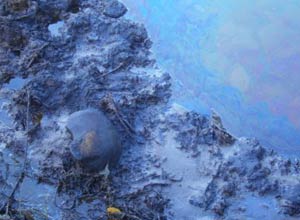Oil Spill at Cuban Refinery
By Café Fuerte

HAVANA TIMES — Workplace negligence resulted in a 15,000-liter oil spill at the Sergio Soto Refinery located in Cabaiguan, in Cuba’s central province of Sancti Spiritus. According to authorities at the facility, the situation is already under control.
Representatives of the province’s Environment Unit (UMA) affiliated to Cuba’s Ministry of Science, Technology and the Environment (CITMA) reported that the incident, described as serious, caused some environmental damage in the area.
“Environmental damage was done, and we know it was due to a technical problem during the refining process,” Magalis Torres Martinez, head of the UMA in Sancti Spiritus, told the local press.
Government authorities have enforced Decree-Law No. 200 (“Violations of Environmental Legislation”) and held four refinery employees responsible, fining them and requesting that they pay for the spilled product as a preventive measure, the plant’s general director, Lester Aleman Hurtado, reported.
Oil Traces in the Tuinucu River
According to engineer and plant director Lester Aleman Hurtado, the oil spill was the result of two separate incidents which took place on August 8 and 15 at the tanker unloading terminal, as a result of the negligence of an operator, who failed to properly secure the residuals trap used to contain the hydrocarbon.
“We hadn’t had an incident of this nature for over a decade, at least not as a result of that trap. What caused it was the negligence of the operator, who did not secure it properly,” Aleman said. “The trap works perfectly well and is releasing clean water into the stream.”
As a result of the spill, some 15,000 liters (14,000 of which have already been recovered), were released into local waters. The remaining volume was pushed upstream as a result of the strong showers in Cabaiguan in recent days.
Traces of the oil spilled onto the Tuinucu River, in the Zaza basin.
Authorities from CITMA and the National Hydraulic Resources Institute visited the refinery to assess the environmental damage caused by the spill.
According to the CITMA office in Sancti Spiritus, no reports of dead fish or affected crops have been received by the oil company in the province since the spill.
Locals Concerned
The stream contaminated by the oil spill is not a source of drinking water but, rather, a place where sewage is released. These waters, however, are used by local farmers to irrigate their crops, and locals are now concerned.
“We were concerned here, because there are rumors that the government isn’t informing us about what’s going on,” Tomas Cañizares, a resident of Cabaiguan, told CafeFuerte. “The local paper [Escambray] took several days to report the incident.”
The spill left oil traces at several surrounding areas and stained the shores of the river.
It is said the UMA will soon conduct an inspection of the surrounding ecosystem to assess the mid and long-term effects of the refinery’s operations and spills, in response to complaints by locals regarding the pollution of the water and the foul smells produced by the refining process.
Founded in December of 1947 as Refineria RECA, the Sergio Soto is one of four oil refineries in Cuba. It refines some 43,000 tons of crude a year.
The facility in Cabaiguan is the only one in the country devoted exclusively to refining domestically produced oil. Though its equipment is relatively old, it processes considerable volumes of crude with high sulfur content in Cuba’s west, in addition to lighter raw materials extracted from reservoirs in Pina and Majagua (Ciego de Avila) and Jarahueca and Jatibonico (Sancti Spiritus).
The refinery is a particularly important producer of dielectric oil used in transformers, manufacturing 1,155 tons a year and substituting imports for a value of over US $1.5 million a year.





